Written by Allen Wyatt (last updated August 24, 2019)
This tip applies to Word 97, 2000, 2002, and 2003
When using the Equation Editor, you can control the spacing it uses between elements of your equation. You enter this spacing as an adjustment to the normal spacing between letters, which is a percentage of the regular spacing. Thus, 150% would be half again as much spacing as normally exists between elements. You set this adjustment as follows:

Figure 1. The Spacing dialog box.
WordTips is your source for cost-effective Microsoft Word training. (Microsoft Word is the most popular word processing software in the world.) This tip (943) applies to Microsoft Word 97, 2000, 2002, and 2003.

Create Custom Apps with VBA! Discover how to extend the capabilities of Office 2013 (Word, Excel, PowerPoint, Outlook, and Access) with VBA programming, using it for writing macros, automating Office applications, and creating custom applications. Check out Mastering VBA for Office 2013 today!
The Equation Editor is a great tool for easily creating fancy-looking equations in your document. One setting you can ...
Discover MoreYou can adjust the distance between the equation body and a limit line.
Discover MoreThe Equation Editor is a handy tool, particularly for those who must include mathematical equations in their documents. ...
Discover MoreFREE SERVICE: Get tips like this every week in WordTips, a free productivity newsletter. Enter your address and click "Subscribe."
There are currently no comments for this tip. (Be the first to leave your comment—just use the simple form above!)
Got a version of Word that uses the menu interface (Word 97, Word 2000, Word 2002, or Word 2003)? This site is for you! If you use a later version of Word, visit our WordTips site focusing on the ribbon interface.
Visit the WordTips channel on YouTube
FREE SERVICE: Get tips like this every week in WordTips, a free productivity newsletter. Enter your address and click "Subscribe."
Copyright © 2025 Sharon Parq Associates, Inc.
Comments